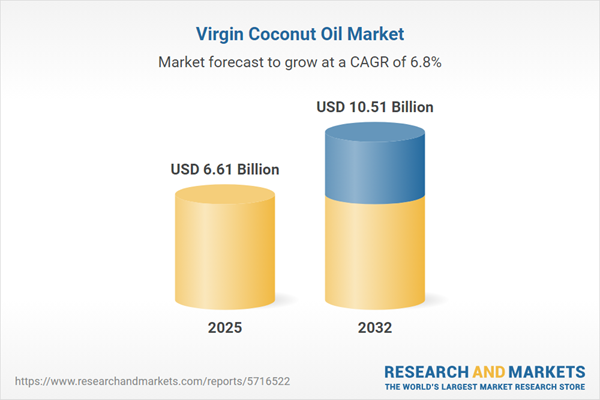Speak directly to the analyst to clarify any post sales queries you may have.
The virgin coconut oil market is evolving rapidly as firms adopt responsible sourcing and greater transparency to meet regulatory demand and stakeholder scrutiny. Decision-makers need targeted market intelligence to drive strategy, respond to disruption, and position their businesses for sustainable growth.
Market Snapshot: Virgin Coconut Oil Market Size and Growth Drivers
The global virgin coconut oil market is currently valued at USD 6.19 billion and is expected to grow to USD 6.61 billion within the year. Looking toward 2032, projections reach USD 10.51 billion, reflecting a strong compound annual growth rate of 6.83%. This growth is underpinned by increased use in food production, wellness solutions, and industrial applications. Significant momentum comes from a clear shift toward clean-label, health-promoting product development, which is driving new regulatory standards and higher benchmarks for quality. Organizations that stay ahead of these changing trends, integrating them into their strategies, are better placed to capture emerging growth opportunities and build robust market positioning.
Scope & Segmentation in the Virgin Coconut Oil Market
This report examines the essential market segments and factors influencing strategic direction, enabling executives to plan effectively, manage risks, and uncover new growth avenues. Segmentation analysis covers:
- Product Category: Includes refined and virgin offerings with a focus on manufacturing advancements and distinct processing techniques to enhance competitive standing.
- Key Applications: Covers uses in food manufacturing, pharmaceuticals, personal care, cosmetics, and biofuels. Each segment involves tailored considerations, such as compliance with food safety, adaptable formulations, and certification requirements, that influence product deployment and market approach.
- Distribution Channels: Encompasses both traditional retail networks and digital commerce platforms. Balancing channel strategies increases market access and reduces vulnerabilities connected to shifting commercial conditions.
- Packaging Types: Considers options such as bulk containers, glass and plastic jars, and flexible packaging, all of which play crucial roles in regulatory compliance, costs, and alignment with regional consumer preferences.
- Regional Coverage: Analyzes markets across the Americas, Europe, Middle East and Africa, and Asia-Pacific. Understanding unique regulatory, logistical, and consumer characteristics within each geographic area is pivotal for strategic planning and global expansion.
- Leading Companies: Profiles major players including Marico Limited, Cargill, Nutiva, Emami, Dr. Bronner’s, Tropical Traditions, KLF Nirmal Industries, Spectrum Organics, NOW Health Group, and Viva Labs, providing reference points for industry performance and enabling informed benchmarking and partnership decisions.
Key Takeaways for Senior Leaders
- Prioritizing clean-label integrity and transparent sourcing enhances trust and aligns businesses with evolving health-focused markets.
- Deepening ethical procurement and traceability across supply chains strengthens supplier credibility and supports compliance with intensifying regulations.
- Integrating advanced extraction processes, such as cold-press and centrifuge technology, supports access to premium sectors positioned around quality and product purity.
- Customizing strategies by region, utilizing sourcing benefits in Asia, and addressing complex regulatory requirements in North America and Europe improves efficiency and responsiveness.
- Using digital supplier management and traceability tools supports agility and enables rapid adaptation as regulations or market expectations shift.
- Engaging in collaborations, including strategic alliances and co-branding, assists in navigating dynamic markets and building organizational resilience.
Tariff Impact on Global Supply Chains
Recent tariff changes in the United States are increasing supply chain complexity for global buyers. Larger firms are broadening supplier networks and strengthening contracts to mitigate risk, while smaller organizations have turned to flexible sourcing methods to reduce potential trade disruptions and increase resilience.
Methodology & Data Sources
This report is based on consultations with industry specialists, engagement with key market stakeholders, and analysis of regulatory, commercial, and competitive data. Strategy frameworks, including value chain mapping and SWOT analysis, are applied and cross-checked using both primary interviews and thorough secondary research.
Why This Report Matters for Senior Leaders
- Provides accurate market metrics and segmentation, delivering actionable insight for investment and compliance strategy.
- Enables procurement and supply teams to evaluate new digital solutions, supporting timely operational adjustments and risk management.
- Supports adaptive decision-making in product development, packaging, and market entry to maintain alignment with regulatory and commercial evolution.
Conclusion
This report offers senior executives clear, actionable insight for navigating regulatory developments, strengthening operational effectiveness, and identifying growth opportunities as the virgin coconut oil market evolves.
Additional Product Information:
- Purchase of this report includes 1 year online access with quarterly updates.
- This report can be updated on request. Please contact our Customer Experience team using the Ask a Question widget on our website.
Table of Contents
3. Executive Summary
4. Market Overview
7. Cumulative Impact of Artificial Intelligence 2025
Companies Mentioned
The companies profiled in this Virgin Coconut Oil market report include:- Marico Limited
- Cargill, Incorporated
- Nutiva, Inc.
- Emami Limited
- Dr. Bronner's, LLC
- Tropical Traditions LLC
- KLF Nirmal Industries Pvt. Ltd.
- Spectrum Organics, LLC
- NOW Health Group, Inc.
- Viva Labs, Inc.
Table Information
| Report Attribute | Details |
|---|---|
| No. of Pages | 192 |
| Published | October 2025 |
| Forecast Period | 2025 - 2032 |
| Estimated Market Value ( USD | $ 6.61 Billion |
| Forecasted Market Value ( USD | $ 10.51 Billion |
| Compound Annual Growth Rate | 6.8% |
| Regions Covered | Global |
| No. of Companies Mentioned | 11 |









